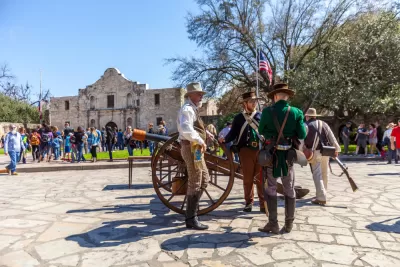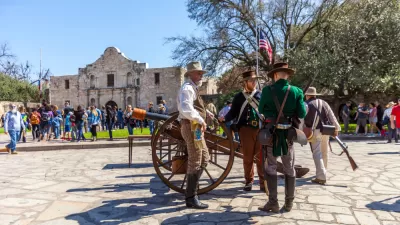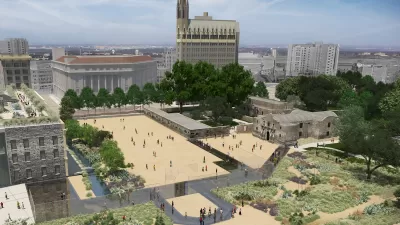Alamo City enters the 300 club.

The city of San Antonio is spending the year celebrating its 300th birthday, with events focused on history, education, arts, and culture scheduled for the entire year. The city also just wrapped up its Commemorative Week, which celebrated the key milestones in the city's creation 300 years earlier. The San Antonio 300 website explains:
On May 1, 1718 the Mission San Antonio de Valero – later known as the Alamo – was established. Four days later the Presidio San Antonio de Bejár was formed to protect the new mission. San Antonio’s five area missions are Texas’ only UNESCO World Heritage site and will be at the forefront of many activities during the Tricentennial year.
The Texas Monthly spent the month of April running a series of articles to capture the city at 300.
A massive urban renewal project that’s reviving plaza culture. An Alamo fight centuries in the making. Avant-garde Mexican food inspired by Maya trade routes. From billionaire Kit Goldsbury to artist Ana Fernandez to former NBA All-Star Tim Duncan, seventeen San Antonians talk about why the historic city might be the most interesting place in America right now.
The articles are collected on the same web page, but we recommend starting with Robert Rivard's story about the ongoing evolution of the Alamo, described as besieged by "commerce and schlock" with "all the gravitas of a saloon." The Alamo Master Plan Management Committee is working hard on a renovation of the Alamo's plaza, to be revealed in the coming months.
FULL STORY: San Antonio at 300

Manufactured Crisis: Losing the Nation’s Largest Source of Unsubsidized Affordable Housing
Manufactured housing communities have long been an affordable housing option for millions of people living in the U.S., but that affordability is disappearing rapidly. How did we get here?

Americans May Be Stuck — But Why?
Americans are moving a lot less than they once did, and that is a problem. While Yoni Applebaum, in his highly-publicized article Stuck, gets the reasons badly wrong, it's still important to ask: why are we moving so much less than before?

Using Old Oil and Gas Wells for Green Energy Storage
Penn State researchers have found that repurposing abandoned oil and gas wells for geothermal-assisted compressed-air energy storage can boost efficiency, reduce environmental risks, and support clean energy and job transitions.

HHS Staff Cuts Gut Energy Assistance Program
The full staff of a federal program that distributes heating and cooling assistance for low-income families was laid off, jeopardizing the program’s operations.

San Antonio Remains Affordable as City Grows
The city’s active efforts to keep housing costs down through housing reforms and coordinated efforts among city agencies and developers have kept it one of the most affordable in the nation despite its rapid population growth.

What Forest Service Cuts Mean for Cities
U.S. Forest Service employees work on projects that have impacts far beyond remote, rural wilderness areas.
Urban Design for Planners 1: Software Tools
This six-course series explores essential urban design concepts using open source software and equips planners with the tools they need to participate fully in the urban design process.
Planning for Universal Design
Learn the tools for implementing Universal Design in planning regulations.
Heyer Gruel & Associates PA
City of Moreno Valley
Institute for Housing and Urban Development Studies (IHS)
City of Grandview
Harvard GSD Executive Education
Salt Lake City
NYU Wagner Graduate School of Public Service
City of Cambridge, Maryland




























